
Original Link: https://www.anandtech.com/show/3971/sandforce-announces-nextgen-ssd-controller-sf2000-capable-of-500mbs-and-60k-iops
SandForce Announces Next-Gen SSDs, SF-2000 Capable of 500MB/s and 60K IOPS
by Anand Lal Shimpi on October 7, 2010 9:30 AM ESTFor months SandForce has been telling me that the market is really going to get exciting once its next-generation controller is ready. I didn’t really believe it, simply because that’s what every company tells me. But in this case, at least based on what SandForce showed me, I probably should have.
What we have today are the official specs of the second-generation SandForce SSDs, the SF-2000 series. Drives will be sampling to enterprise customers in the coming weeks, but we probably won’t see shipping hardware until Q1 2011 if everything goes according to plan. And the specs are astounding:
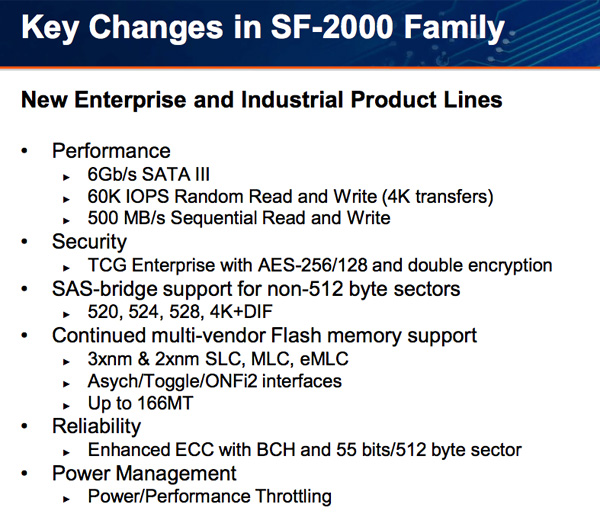
We'll get to the how in a moment, but let's start at the basics. The overall architecture of the SF-2000 remains unchanged from what we have today with the SF-1200/SF-1500 controllers.
SandForce’s controller gets around the inherent problems with writing to NAND by simply writing less. Using real time compression and data deduplication algorithms, the SF controllers store a representation of your data and not the actual data itself. The reduced data stored on the drive is also encrypted and stored redundantly across the NAND to guarantee against dataloss from page level or block level failures. Both of these features are made possible by the fact that there’s simply less data to manage.
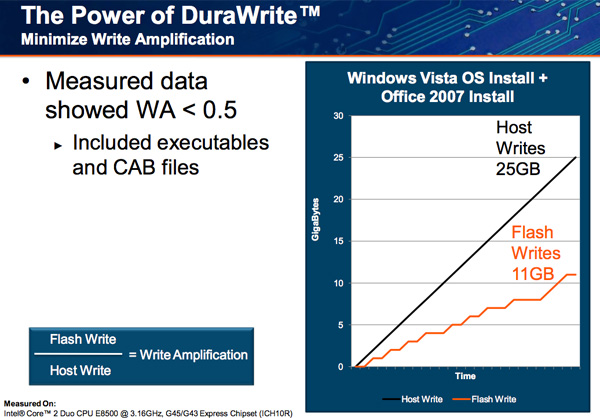
Another side effect of SandForce’s write-less policy is there’s no need for an external DRAM to handle large mapping tables. It reduces the total BOM cost of the SSD and allows SandForce to charge a premium for its controllers.
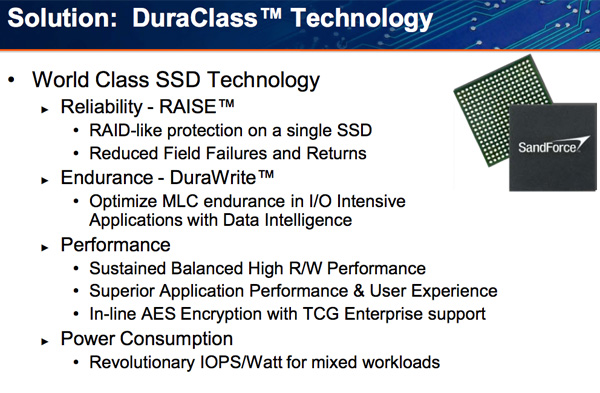
These are the basics and as I mentioned above, they haven’t changed. The new SF-2000 controller is faster but the fundamental algorithms remain the same. The three areas that have been improved however are the NAND interface, the on-chip memories, and the encryption engine.
NAND Support: Everything
The SF-2000 controllers are NAND manufacturer agnostic. Both ONFI 2 and toggle interfaces are supported. Let’s talk about what this means.
Legacy NAND is written in a very straight forward manner. A write enable signal is sent to the NAND, once the WE signal is high data can latch to the NAND.
Both ONFI 2 and Toggle NAND add another bit to the NAND interface: the DQS signal. The Write Enable signal is still present but it’s now only used for latching commands and addresses, DQS is used for data transfers. Instead of only transferring data when the DQS signal is high, ONFI2 and Toggle NAND support transferring data on both the rising and falling edges of the DQS signal. This should sound a lot like DDR to you, because it is.
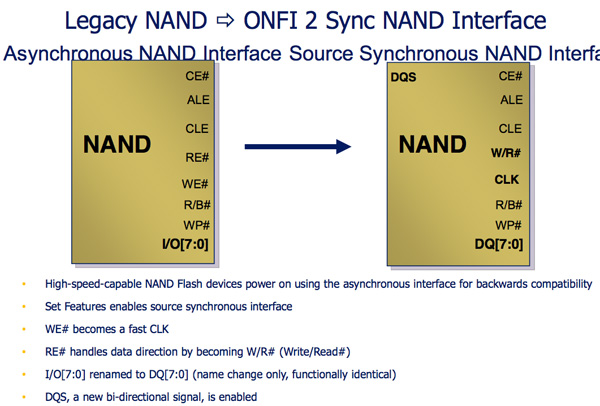
The benefit is tremendous. Whereas the current interface to NAND is limited to 40MB/s per device, ONFI 2 and Toggle increase that to 166MB/s per device.
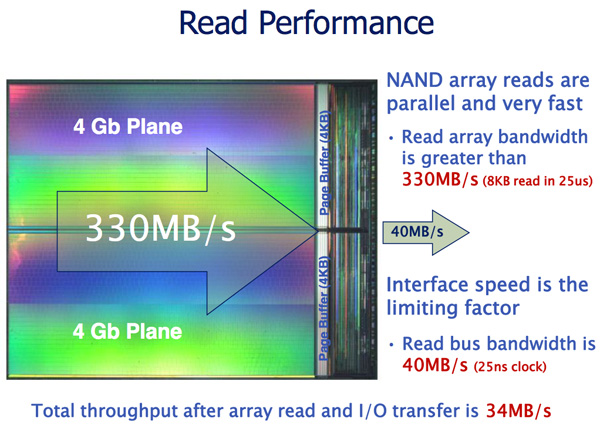
Micron indicates that a dual plane NAND array can be read from at up to 330MB/s and written to at 33MB/s. By implementing an ONFI 2 and Toggle compliant interface, SandForce immediately gets a huge boost in potential performance. Now it’s just a matter of managing it all.
The controller accommodates the faster NAND interface by supporting more active NAND die concurrently. The SF-2000 controllers can activate twice as many die in parallel compared to the SF-1200/1500. This should result in some pretty hefty performance gains as you’ll soon see. The controller is physically faster and has more internal memory/larger buffers in order to enable the higher expected bandwidths.
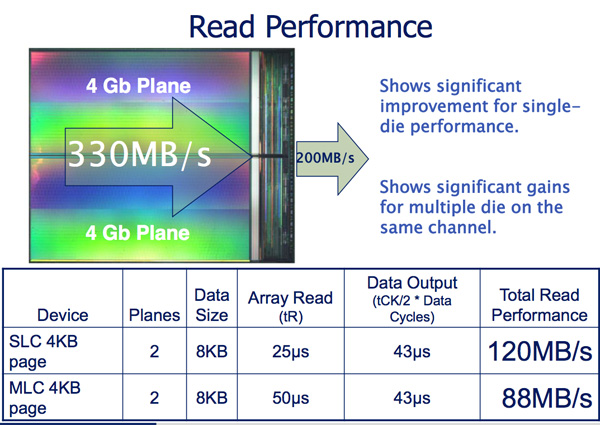
Initial designs will be based on 34nm eMLC from Micron and 32nm eMLC from Toshiba. The controller does support 25nm NAND as well, so we’ll see a transition there when the yields are high enough. Note that SandForce, like Intel, will be using enterprise grade MLC instead of SLC for the server market. The demand pretty much requires it and luckily, with a good enough controller and NAND, eMLC looks like it may be able to handle a server workload.
Performance: Welcome to the 500 Club
Let’s talk peak performance specs. I must preface this with a warning, all of the numbers you’re about to see are SandForce’s estimates and projections for how the SF-2000 series will perform. Next week you’ll see some basic functionality and performance testing but as far as I know, these numbers haven’t been reached yet. SandForce is confident that it will hit them once drives start shipping, but until then take what you are about to see with a grain of salt.
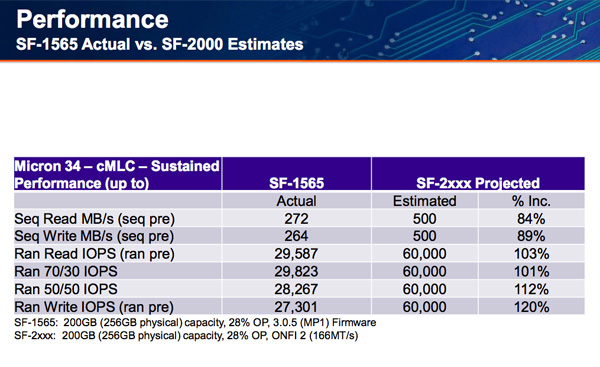
Random read and write performance goes up significantly over the SF-1200/1500. We are at 40K IOPS today, and SandForce is promising 60K IOPS with the SF-2000. Note that this is not only higher than anything shipping today, it’s even higher than what we recently found out about Intel’s 3rd generation X25-M/X25-E SSDs.
Now the shocker. Thanks to 6Gbps and ONFI 2/Toggle support, the SF-2000 will support up to 500MB/s sequential read and write speeds. On an 8 channel device that’s actually only 62.5MB/s per channel but the combined bandwidth is just ridiculous for a single drive. At full speed you could copy 1GB of data from a SF-2000 drive to another SF-2000 drive in 2 seconds. If SandForce can actually deliver this sort of performance I will be blown away.
Let’s talk about reality for a second. SandForce quotes standard iometer numbers, which are usually quite optimistic for SandForce's controllers. I’d expect real world performance to be a bit below these figures but not by a lot for many workloads.
In the SF-1200/1500 series, SandForce used enterprise features to differentiate the two controllers. You got some improved reliability and a giant capacitor with the SF-1500 designs, but you didn’t really get any added performance. With the SF-2000 series, we will see more differentiation between the enterprise and consumer parts. SandForce indicated that the consumer version of the SF-2000 would have a different level of performance. I get the impression that the specifics of the consumer drive haven’t been determined yet. I’ve already started campaigning to see a full spec version in the consumer market but it’s still far too early to tell what will be shipped. If the 3rd generation X25-M is really only capable of 270MB/s reads and 170MB/s writes, I’m not sure if there will be the motivation to deliver a 500/500MBps part into the enthusiast market.
Security: AES-256 and Double Encryption
The SF-1200/1500 controllers have a real time AES-128 encryption engine. Set a BIOS password and the drive should be locked unless you supply that password once again (note I haven’t actually tried this). The SF-2000 implements an AES-256 engine and supports double encryption. The former enables stronger encryption, while the latter allows you to set a different encryption key for multiple address ranges on the drive.
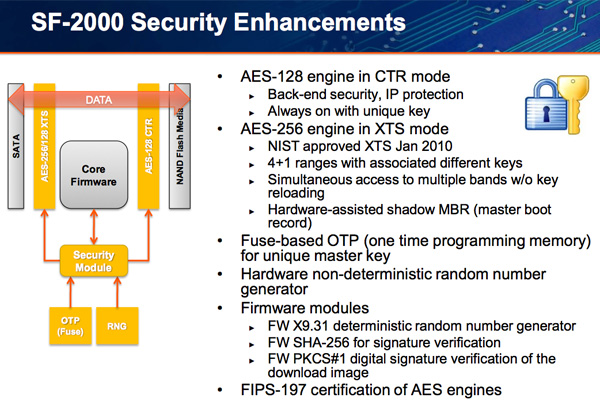
Enhanced ECC
As NAND densities go up, so will error rates and in response SandForce boosted the error correction engine on its controller. The SF-2000 error checks and corrects at a 512-byte granularity with a 55-bit BCH, up from 24-bits per 512-bytes.
The Family
SandForce is announcing three parts today: the SF-2300, SF-2500 and SF-2600. All three controllers have the same performance specs but differ in features.
The SF-2500 is the base enterprise drive. For industrial use there’s the SF-2300 that can operate at more ridiculous temperatures. The SF-2600 ships with the external SAS bridge and a special firmware revision to enable support for non-512B sectors.
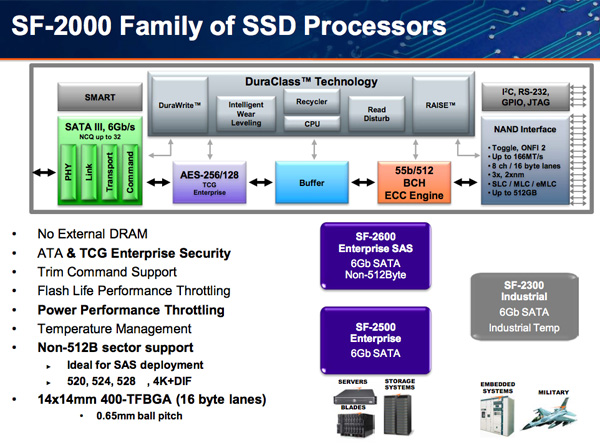
Many enterprise storage systems use larger-than-512B sectors to store error correction information among other things. These sizes can be awkward like 520 bytes, 524 bytes, 528 bytes or even a 4K sector with an additional data integrity field. Currently the SF-1200/1500 controllers support these non-standard sector sizes, but you run into performance issues since writes aren’t aligned to how the drive is organized internally. With the SF-2600, there’s firmware support for any one of these sector types. The drive handles alignment issues in hardware, presumably without any performance overhead. SandForce indicated that you’d need to configure the drive for sector size in the firmware, meaning the adjustment isn’t dynamic.
Since this is a very particular type of enterprise SSD feature that’s usually seen in SAS devices, the SF-2600 is paired with a native SAS to SATA bridge. The controller is still SATA internally but the SF-2600 reference design will feature a SAS bridge on-board.
All of the enterprise SF-2000 controllers support TRIM. They also support performance throttling based on remaining program/erase cycles on the drive’s NAND (slow down the drive so the NAND lasts longer, as well as power based performance throttling (slow down the drive to reduce power consumption). SandForce hasn’t announced power specs for the SF-2000 drives, but given Intel’s drive power went up with the 3rd generation X25s I would expect something similar here.
The consumer member of the SF-2000 family will be announced sometime early next year. We will hopefully see a fairly high end version of the consumer part, missing only the enterprise specific features but retaining all of the performance.
Final Words
SandForce conveyed to me that although we may see hardware this year, production firmware and silicon won’t be ready until early Q1. Anything that ships before then is not what SandForce considers production worthy. This is an important distinction as SandForce’s partners often ship with pre-release hardware/firmware in order to gain traction and sales as quickly as possible. We’ll probably see less of this as SandForce matures as a company.
The specs behind the SF-2000 are downright amazing. If SandForce can deliver this sort of performance within two quarters I will be floored. If we’re talking about 500MB/s for a single drive next year, the sort of performance you’ll be able to get through a multi-drive array will be staggering. We’re easily heading towards gigabytes per second of affordable I/O bandwidth, not to mention that SandForce will have nearly maxed out 6Gbps SATA on its first attempt.
We will of course see drives from the usual suspects. OCZ, Corsair and even Seagate is now officially listed as a SandForce customer. Looks like those Pulsar rumors were true.
There’s still a long way to go before we’re at the point where we have a shipping SF-2xxx based drive with these specs however. If you remember the growing pains that Intel, Indilinx, Micron and SandForce all experienced with this current generation of controllers, I don’t expect the next round to be any easier.
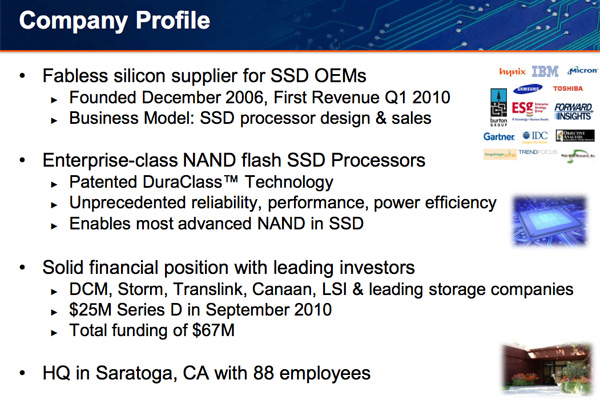
SandForce is serious however. The company only has 88 employees but it just closed another round of funding ($25M Series D), bringing the total funding to $67M. The company is headed for an IPO. And if it can pull off the SF-2000 we saw on paper today, SandForce may have the sales to support it.







